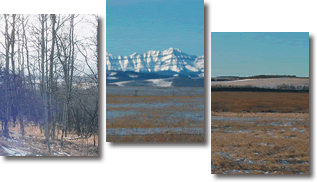

Richard Gaskell, Mentor teacher from Galileo Educational Network
A key component in the Artistry of the Land, Ancient Stories and Art
of our First Nations People project, was the ability for students and
teachers to think with technology. They did this by connecting to other
classes to view and compare other students' observations and interpretations
and extend their inquiries. We all had the opportunity to learn how to
think with technology and become more aware of the considerations and
decisions that need to be thought about when working in a digital environment.
There is a fallacy that until or unless you are trained in the use of
the tool, nothing of value can happen. In education teachers often express
reluctance to use technology in the classroom until the teacher has mastered
the tool. This falls so much into the paradigm of teacher as all-knowing
expert.
In fact, much can happen starting at an entry level and can develop explosively
in response to users' demands if the context is rich and the content is
deep. The teacher who jumps into a project with access to in-time support
is much like someone learning to ride a bicycle. Hand-holding progresses
to a nudge here or a suggestion there until the learner shoots off without
a backward glance into uncharted territory much faster than the teacher
can keep up. Not only does the bicycle rider or the technology user not
look back, but they forget the bumped knees and scrapes of the early learning.
There is also a fallacy that when you are planning a project that incorporates
technology, that you have to plan for the technology first. I know that
if the emphasis is on the technology, the essence of the purposefulness
of the content is lost. So it is vital that what we do is guided by effective
teaching and learning practice, and that technology - and the enablement
it can provide - contributes seamlessly to the learning environment.
This becomes part of the brainstorming process with the understanding
that the project must be able to stand on its own. The technology then
becomes part of the project - supporting the project as transparently
and seamlessly as possible. The important part for me in this is helping
fellow teachers understand the possibilities presented by the present
environment so that we can move from, "Is this possible?" to,
"This is possible." It is embedded professional development.
|

